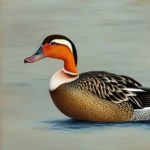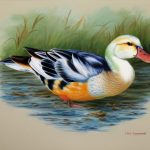Ducks are a popular choice for poultry farming due to their versatility, adaptability, and ease of care. Among the many different breeds of ducks, tan and white duck breeds are particularly popular for their unique characteristics and attractive appearances. These breeds are known for their beautiful plumage, friendly dispositions, and excellent egg-laying abilities. Tan and white duck breeds come in a variety of sizes and shapes, making them suitable for different purposes, whether it’s for egg production, meat, or ornamental purposes. In this article, we will explore the characteristics, popular breeds, care and maintenance, breeding and raising, uses, and a summary of tan and white duck breeds.
Table of Contents
- 1 Characteristics of Tan and White Duck Breeds
- 2 Popular Breeds of Tan and White Ducks
- 3 Care and Maintenance of Tan and White Duck Breeds
- 4 Breeding and Raising Tan and White Ducks
- 5 Uses of Tan and White Ducks
- 6 Conclusion and Summary of Tan and White Duck Breeds
- 7 FAQs
- 7.1 What are some tan and white duck breeds?
- 7.2 What are the characteristics of tan and white duck breeds?
- 7.3 What is the average size of tan and white duck breeds?
- 7.4 What is the purpose of raising tan and white duck breeds?
- 7.5 What type of environment do tan and white duck breeds thrive in?
- 7.6 What should be considered when raising tan and white duck breeds?
Key Takeaways
- Tan and white duck breeds are popular for their unique coloration and characteristics
- These ducks are known for their friendly and calm nature, making them great for backyard or farm settings
- Popular breeds include the Khaki Campbell, Indian Runner, and Pekin ducks
- Care and maintenance of tan and white duck breeds includes providing proper housing, feeding, and healthcare
- Breeding and raising tan and white ducks can be a rewarding experience, with potential for egg production and meat consumption
Characteristics of Tan and White Duck Breeds
Tan and white duck breeds are known for their striking appearances and unique characteristics. These ducks typically have a combination of tan, brown, and white feathers, which give them a beautiful and distinctive look. Their plumage can vary in patterns and shades, making each individual duck visually appealing. In addition to their appearance, tan and white duck breeds are also known for their friendly and docile dispositions. They are generally easy to handle and can be quite sociable, making them great additions to a backyard flock or farm. Tan and white ducks are also known for their excellent egg-laying abilities. They are reliable layers and can produce a good number of eggs throughout the year, making them a valuable addition to any poultry operation. Additionally, these ducks are known for their hardiness and adaptability to various climates, making them suitable for different environments.
On the other hand, tan and white duck breeds also have some specific characteristics that make them stand out from other duck breeds. For example, some tan and white duck breeds are known for their excellent foraging abilities. They are natural foragers and can help control pests in a garden or farm setting. Additionally, some tan and white duck breeds are known for their meat production qualities. They can grow to a good size and provide a flavorful and lean meat option for those interested in raising ducks for meat. Overall, tan and white duck breeds have a unique combination of characteristics that make them versatile and valuable for various purposes.
Popular Breeds of Tan and White Ducks
There are several popular breeds of tan and white ducks that are favored by poultry enthusiasts and farmers alike. One of the most well-known tan and white duck breeds is the Indian Runner duck. This breed is characterized by its upright stance and distinctive running gait, which sets it apart from other duck breeds. Indian Runner ducks come in a variety of colors, including tan and white, and are known for their excellent egg-laying abilities. They are also valued for their foraging skills and adaptability to different environments.
Another popular breed of tan and white ducks is the Khaki Campbell. This breed is known for its khaki-colored plumage, which can range from light tan to dark brown. Khaki Campbells are prized for their exceptional egg-laying abilities, with some individuals laying up to 300 eggs per year. They are also known for their calm and friendly dispositions, making them a popular choice for backyard flocks.
The Welsh Harlequin is another popular tan and white duck breed that is favored for its attractive appearance and excellent egg-laying abilities. This breed is characterized by its silver or apricot-colored plumage with distinct white markings. Welsh Harlequins are known for their docile nature and adaptability to various climates, making them a versatile choice for poultry enthusiasts.
Care and Maintenance of Tan and White Duck Breeds
When it comes to caring for tan and white duck breeds, there are several important considerations to keep in mind. These ducks require proper housing, nutrition, and healthcare to ensure their well-being and productivity. Housing for tan and white ducks should provide protection from predators and the elements while allowing ample space for movement and foraging. A secure coop or shelter with access to clean water is essential for keeping these ducks healthy and happy.
In terms of nutrition, tan and white duck breeds require a balanced diet that includes a combination of commercial duck feed, fresh greens, grains, and access to clean water. It’s important to provide a diet that meets their nutritional needs for optimal growth, egg production, and overall health. Additionally, providing access to a pond or shallow water source is beneficial for tan and white ducks as they enjoy swimming and foraging in water.
Healthcare for tan and white duck breeds involves regular monitoring for signs of illness or injury, as well as routine vaccinations and parasite control. It’s important to work with a veterinarian who is knowledgeable about duck care to ensure that these birds receive proper healthcare when needed. Overall, providing proper housing, nutrition, and healthcare is essential for the care and maintenance of tan and white duck breeds.
Breeding and Raising Tan and White Ducks
Breeding and raising tan and white ducks can be a rewarding experience for poultry enthusiasts and farmers. When it comes to breeding these ducks, it’s important to select healthy breeding stock with desirable traits such as good egg-laying abilities, attractive plumage, and friendly dispositions. Breeding tan and white ducks should be done with careful consideration of genetic diversity to maintain the health and vigor of the offspring.
Raising tan and white ducklings involves providing proper brooding conditions, including warmth, access to food and water, and protection from predators. As the ducklings grow, they will require appropriate housing that allows for ample space to move around and access to water for swimming. Providing a balanced diet that meets the nutritional needs of growing ducks is essential for their development.
It’s important to monitor the health and growth of young ducks closely to ensure they are thriving. As they mature, tan and white ducks will begin to exhibit their unique characteristics and behaviors, making it an exciting experience to watch them grow. Overall, breeding and raising tan and white ducks requires careful planning, attention to detail, and dedication to ensuring the well-being of the ducks.
Uses of Tan and White Ducks

Tan and white ducks have several uses that make them valuable additions to a farm or backyard flock. One of the primary uses of these ducks is egg production. Tan and white duck breeds are known for their excellent egg-laying abilities, making them a reliable source of fresh eggs for consumption or sale. Their eggs are prized for their rich flavor and nutritional value, making them a popular choice among poultry enthusiasts.
In addition to egg production, some tan and white duck breeds are also raised for meat. These ducks can provide a flavorful and lean meat option that is valued by those looking for alternative protein sources. Their meat is often used in culinary dishes around the world due to its unique flavor profile.
Furthermore, tan and white ducks are also valued for their pest control abilities. These ducks are natural foragers and can help control pests such as slugs, snails, insects, and weeds in a garden or farm setting. Their foraging skills make them an eco-friendly option for pest management without the use of chemicals.
Lastly, some tan and white duck breeds are also raised for ornamental purposes due to their attractive plumage and unique appearances. These ducks can be showcased in exhibitions or kept as pets due to their friendly dispositions.
Conclusion and Summary of Tan and White Duck Breeds
In conclusion, tan and white duck breeds are valued for their unique characteristics, versatility, and uses in various agricultural settings. These ducks are known for their striking appearances, excellent egg-laying abilities, friendly dispositions, meat production qualities, pest control abilities, and ornamental value. Popular breeds of tan and white ducks include the Indian Runner, Khaki Campbell, Welsh Harlequin, among others. Caring for these ducks involves providing proper housing, nutrition, healthcare, breeding, raising young ducks with care while ensuring their well-being throughout their lives.
Overall, tan and white duck breeds offer numerous benefits to poultry enthusiasts and farmers alike due to their adaptability, productivity, and diverse uses. Whether it’s for egg production, meat, pest control, or ornamental purposes, these ducks have proven themselves to be valuable additions to any poultry operation or backyard flock. With proper care and attention to their specific needs, tan and white duck breeds can thrive while providing numerous benefits to those who raise them.
If you’re considering raising tan and white duck breeds, you may also be interested in learning about the best kind of coop for chickens. Check out this article on what kind of coop is best for chickens to ensure you have the right setup for your feathered friends.
FAQs
What are some tan and white duck breeds?
Some tan and white duck breeds include the Indian Runner, Khaki Campbell, and Saxony.
What are the characteristics of tan and white duck breeds?
Tan and white duck breeds typically have a slender body, upright posture, and a tan and white feather pattern. They are known for their excellent egg-laying abilities and calm temperament.
What is the average size of tan and white duck breeds?
Tan and white duck breeds are generally medium-sized ducks, with the Indian Runner and Khaki Campbell weighing around 4-5 pounds and the Saxony weighing around 7-8 pounds.
What is the purpose of raising tan and white duck breeds?
Tan and white duck breeds are often raised for their high egg production, as they are known to lay a large number of eggs throughout the year. They are also kept for their meat and as ornamental birds.
What type of environment do tan and white duck breeds thrive in?
Tan and white duck breeds thrive in a free-range environment with access to water for swimming and foraging. They also require shelter to protect them from predators and the elements.
What should be considered when raising tan and white duck breeds?
When raising tan and white duck breeds, it is important to provide them with a balanced diet, access to clean water, and proper housing. Additionally, regular health checks and protection from predators are essential for their well-being.
Meet Walter, the feathered-friend fanatic of Florida! Nestled in the sunshine state, Walter struts through life with his feathered companions, clucking his way to happiness. With a coop that’s fancier than a five-star hotel, he’s the Don Juan of the chicken world. When he’s not teaching his hens to do the cha-cha, you’ll find him in a heated debate with his prized rooster, Sir Clucks-a-Lot. Walter’s poultry passion is no yolk; he’s the sunny-side-up guy you never knew you needed in your flock of friends!







